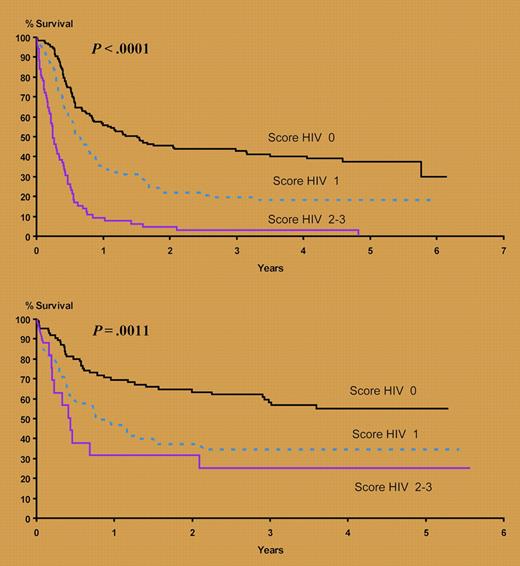Comment on Mounier et al, page 3832
The final results of one of the largest clinical trials ever conducted for AIDS-related non-Hodgkin lymphoma with simplified prognostic indicators are reported by Mounier and colleagues in this issue of Blood.
Between 1993 and 1999, 485 patients in 55 centers in the Groupe d'Étude des Lymphomes de l'Adulte (GELA) and the Gruppo Italiano Coooperativo AIDSe Tumori (GICAT) were enrolled in 3 randomized clinical trials according to a stratification to a model for AIDS status using 3 adverse risk factors: Eastern Cooperative Oncology Group performance status 2 to 4, prior AIDS diagnosis, and a CD4 cell count less than 0.10 × 109/L (100/mm3). Patients with no risk factors were randomized to 4 cycles of standard cyclophosphamide, vincristine, doxorubicin, and prednisolone (CHOP) or 3 cycles of a more intensive regimen, doxorubicin, cyclophosphamide, vindesine, bleomycin, and prednisolone (ACVBP). Patients with 1 risk factor were randomized to 4 cycles of standard CHOP or 4 cycles of low-dose CHOP, and those with 2 or 3 risk factors to 4 cycles of low-dose CHOP or 12 treatments with vincristine and prednisolone. There was no difference in 5-year overall survival between the patients in each arm of all 3 stratifications.FIG1
Overall survival of patients with AIDS-related lymphomas according to HIV score in pre-HAART (top, P < .0001) and post-HAART (bottom, P < .0011) eras. See the complete figure in the article beginning on page 3832.
Overall survival of patients with AIDS-related lymphomas according to HIV score in pre-HAART (top, P < .0001) and post-HAART (bottom, P < .0011) eras. See the complete figure in the article beginning on page 3832.
Results were analyzed according to lymphoma status (International Prognostic Index [IPI]), entry into the trial before and after 1996 when highly active antiretroviral therapy (HAART) was introduced, and an older prognostic model. The strongest predictors of survival were AIDS status, lymphoma status (IPI), and use of HAART. The number of patients with 2 to 3 AIDS factors was significantly reduced by HAART. This subset analysis of a prospective study confirms the observation noted in retrospective analyses1 that the survival of patients with AIDS-related lymphomas has improved with HAART and is now approaching that of patients with similar lymphomas in patients without HIV infection (see figure). It also confirms the utility of the IPI.
Deaths due to AIDS are less common in patients with AIDS-related lymphomas with preserved immune and associated bone marrow functions who receive HAART. As a result, older prognostic models that used both AIDS and lymphoma factors are now less useful. Although the results with 4 cycles of CHOP in patients with no AIDS risk factors were good, superior overall results have been reported with more prolonged infusion chemotherapy.2 However, unlike most B-cell lymphomas where the addition of rituximab to chemotherapy has improved the outcome, improvements in tumor response in AIDS-related lymphomas have been tempered by infectious deaths, particularly in patients with poor immune function.3 Patients with AIDS-related Burkitt lymphomas often have well-preserved immune function with or without HAART, and they can now be expected to have an outcome similar to that of patients without HIV infection with intensive treatment.4,5 Clearly, we have entered a new era with HAART in which treatment can now be directed to the aggressive lymphomas seen with HIV infection without as much concern for the complications of AIDS. ▪


This feature is available to Subscribers Only
Sign In or Create an Account Close Modal